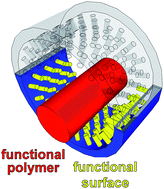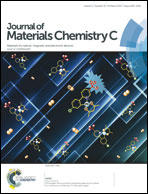Wiring functional groups in mesoporous organosilica materials†
Abstract
Developing future stimuli-responsive materials into more sensitive and more specific devices requires that different entities with advanced functionalities can be organized precisely, allowing them to display cooperative action. Combining the profile of properties of mesoporous materials with a large amount of organically functionalized surfaces on the one hand and conducting polymers on the other hand, for instance the polythiophene family, could lead to interesting smart materials. We show how the surface groups in periodically ordered mesoporous organosilicas (PMOs) can be electrically contacted by means of intrapore polymerization of significant amounts of poly-3,4-ethylenedioxythiophene (PEDOT). Cyclic voltammetry measurements of RuII coordinated to the surfaces show that electrochemical charging and discharging of the material is possible. Further, the resulting, novel nanohybrid PEDOT@PMO material is capable of distinguishing between transition metal species according to the degree of Lewis-acidity. The latter was explored using impedance spectroscopy.


 Please wait while we load your content...
Please wait while we load your content...